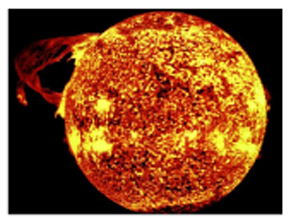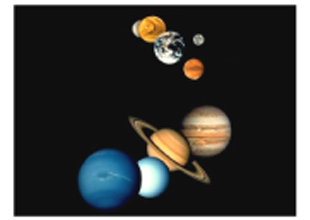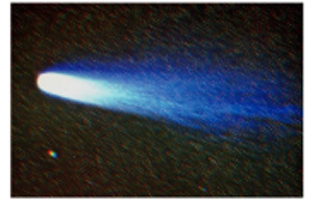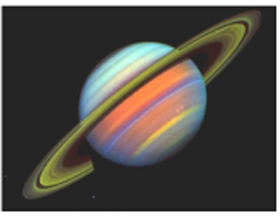OUR YOUNG SOLAR SYSTEM
DID our Solar System originate from a cloud of cold dust and gas about 4.6 billion years ago, or did it have a recent origin as part of the six-day creation recorded in the Bible? The 'cold-nebula' theory, as it is called, is currently the most popular hypothesis, not because it can be proved, but because it is the best explanation secular scientists can find for the solar system's existence without believing in special creation. The theory, however, rests purely on speculation, and there are a number of evidences that our solar system is quite young, which means that there has just not been enough time for evolution. We will examine a few of these.
THE SUN
 Most cosmologists believe that our sun produces its energy by thermonuclear fusion. If this is so, it is large enough to shine for as long as ten billion years. Supposedly the Sun has been a 'main sequence' star since its formation. The 'main sequence' is thought to be a period of stability lasting for most of a star's life — about ten billion years. In 4.6 billion years our sun should have used about half its energy store, with about half the hydrogen in its core replaced by helium, which means that today the Sun should be nearly 40%brighter than it was 4 billion years ago. The problem for evolutionists with this scenario is that the sun would have been too cool for life to have arisen in the way they claim. Geological evidence shows that average global temperatures have varied little, so if the sun had been hot enough to support life 4.6 billion years ago, it ought to be much too hot now! This program is known as the 'early faint sun paradox'. Attempts have been made to solve the problem, but the simplest solution is to reject the old-earth view. Astronomer Dr. Danny Faulkner has dealt with this issue at some length.1
Most cosmologists believe that our sun produces its energy by thermonuclear fusion. If this is so, it is large enough to shine for as long as ten billion years. Supposedly the Sun has been a 'main sequence' star since its formation. The 'main sequence' is thought to be a period of stability lasting for most of a star's life — about ten billion years. In 4.6 billion years our sun should have used about half its energy store, with about half the hydrogen in its core replaced by helium, which means that today the Sun should be nearly 40%brighter than it was 4 billion years ago. The problem for evolutionists with this scenario is that the sun would have been too cool for life to have arisen in the way they claim. Geological evidence shows that average global temperatures have varied little, so if the sun had been hot enough to support life 4.6 billion years ago, it ought to be much too hot now! This program is known as the 'early faint sun paradox'. Attempts have been made to solve the problem, but the simplest solution is to reject the old-earth view. Astronomer Dr. Danny Faulkner has dealt with this issue at some length.1
Another line of research suggests that the sun is shrinking by about 1/10 of a per cent per century.2 This would give the solar system a maximum age of 100,000 years, since that long ago the sun would have been twice its present size. Other scientists have come up with the much smaller rate of shrinkage of 0.02 second of arc per century, but even this would mean that 100 million years ago the sun would have been much too large for life to exist.3 Either way, belief in a 4.6 billion-year-old sun presents problems, but the problem disappears if we accept the Biblical view of the age of the solar system.
THE MOON
 The moon, is receding from the earth at about 4 cm (1.5 inches) per year, and the rate would have been greater in the past. Now, the moon could never have been closer to earth then 18,400 km (11,500 miles) — a distance known as the Roche Limit — because within the limit Earth's tidal forces would have shattered the moon. This destroys the theory that the moon originated as part of the earth, but it also puts an upper limit on the age of the earth-moon system. Even if the moon had once been in contact with the earth, it would have taken 'only' 1.37 billion years to reach its present distance — less than 301f its supposed age, and, as we have seen, it could never have been closer than 18,400 km.4 Note that this is the maximum possible age, but far too young for evolution.
The moon, is receding from the earth at about 4 cm (1.5 inches) per year, and the rate would have been greater in the past. Now, the moon could never have been closer to earth then 18,400 km (11,500 miles) — a distance known as the Roche Limit — because within the limit Earth's tidal forces would have shattered the moon. This destroys the theory that the moon originated as part of the earth, but it also puts an upper limit on the age of the earth-moon system. Even if the moon had once been in contact with the earth, it would have taken 'only' 1.37 billion years to reach its present distance — less than 301f its supposed age, and, as we have seen, it could never have been closer than 18,400 km.4 Note that this is the maximum possible age, but far too young for evolution.
A study of lunar rock samples has also produced evidence for a young moon. All materials have a degree of viscosity, and even rocks deform over time. The fresh-looking condition of lunar craters means they cannot be several billion years old. Geophysicist and astronomer Harold Slusher and two other scientists calculated that these rocks have a maximum age of a few million years.5 There is also evidence that the moon is seismically active and still cooling.
COMETS
 Comets have very elongated orbits, approaching close to the sun and then disappearing near the edge of the solar system. Short-term comets, such as Halley's have a period of less than 150 years. Comets have been described as 'dirty snowballs' consisting of particles of ice, dust and debris. Whenever they approach the sun, emissions of energy from the sun 'blow off' parts of the comet's head. (This is why the tail always points away from the sun). If our solar system were really 4.6 billion years old, there would be no short-term comets left, due to their rapid disintegration. Space scientists, aware of the implications, have suggested that they are replenished from a vast shell of comets which lies outside the solar system, 'too far away' to be observed. This is called the 'Oort Cloud' after the Dutchman who invented the concept. However, British astronomer J. A. Littleton demolished Oort's theory in an article in a scientific journal.6 The presence of these comets indicates that the solar system is not more than about 10,000 years old.
Comets have very elongated orbits, approaching close to the sun and then disappearing near the edge of the solar system. Short-term comets, such as Halley's have a period of less than 150 years. Comets have been described as 'dirty snowballs' consisting of particles of ice, dust and debris. Whenever they approach the sun, emissions of energy from the sun 'blow off' parts of the comet's head. (This is why the tail always points away from the sun). If our solar system were really 4.6 billion years old, there would be no short-term comets left, due to their rapid disintegration. Space scientists, aware of the implications, have suggested that they are replenished from a vast shell of comets which lies outside the solar system, 'too far away' to be observed. This is called the 'Oort Cloud' after the Dutchman who invented the concept. However, British astronomer J. A. Littleton demolished Oort's theory in an article in a scientific journal.6 The presence of these comets indicates that the solar system is not more than about 10,000 years old.
SATURN'S RINGS
 The rings of Saturn have long puzzled stargazers, but the Voyager 1 mission revealed even greater mysteries. Close-up photographs show that there are thousands of rings — like the grooves on a gramophone record — and, amazingly, some are braided like a rope! There are also spoke-like structures within the rings, which scientists have difficulty in explaining. Some, like Larry W. Esposito, have been forced to admit that Saturn's rings are 'relatively young objects', and that 'the rings we have seen through Voyager's eyes ... could not have lasted the billions of years since the formation of the planet.'7 We noticed that he does not question the accepted age of the solar system.
The rings of Saturn have long puzzled stargazers, but the Voyager 1 mission revealed even greater mysteries. Close-up photographs show that there are thousands of rings — like the grooves on a gramophone record — and, amazingly, some are braided like a rope! There are also spoke-like structures within the rings, which scientists have difficulty in explaining. Some, like Larry W. Esposito, have been forced to admit that Saturn's rings are 'relatively young objects', and that 'the rings we have seen through Voyager's eyes ... could not have lasted the billions of years since the formation of the planet.'7 We noticed that he does not question the accepted age of the solar system.
These evidences that our solar system is young mean that there has been no time for evolution! The only alternative is creation by the word of God, as recorded in the Bible.
REFERENCES:
- 'The Young Faint Sun Paradox and the Age of the Solar System', Institute for Creation Research Impact No. 300, 1998
- John Eddy and Aram Boomazian 'Analysis of Historical Data Suggest Sun Is Shrinking', Physics Today, Vol. 32, No. 9, Sept. 1979, p. 17.
- F.R. Stephenson, 'The earliest known record of a solar eclipse', Nature 228, 1970, pp. 651-652.
- Dr Don de Young, 'The Earth-Moon System', Proceedings of the 2nd International Conference on Creationism, Creation Science Fellowship Inc., Pittsburgh, 1990. pp. 79-83.
- The Age of Lunar Craters, Creation Research Society Quarterly No. 20, Sept. 1983, pp. 105-108.
- 'The Nonexistence of the Oort Cometary Shell', Astrophysics & Space Science Vo. 31, 1974, pp. 385-401
- 'The Changing Shape of Planetary Rings', Astronomy Vol. 15, No. 9. September 1987, p. 14.
Factsheets published regularly by Creation Resources Trust, P.O. Box 3237, YEOVIL, BA22 7RQ.
Registered Charity No. 1016666. www.c-r-t.co.uk © 2003. (Photos by NASA)

